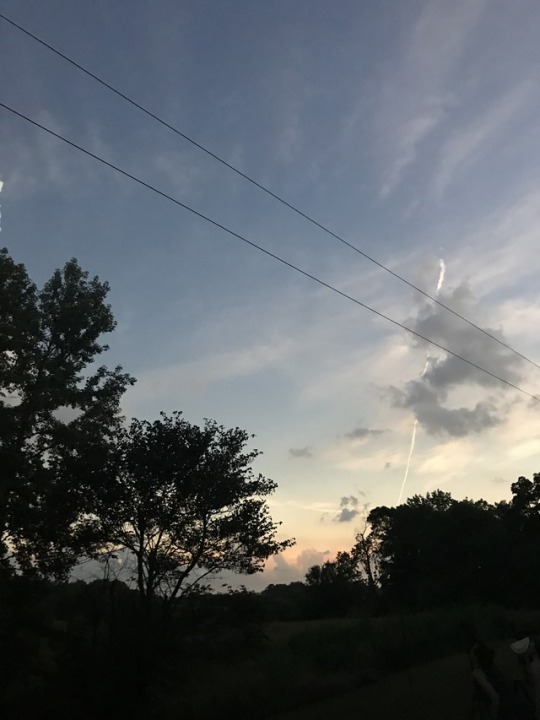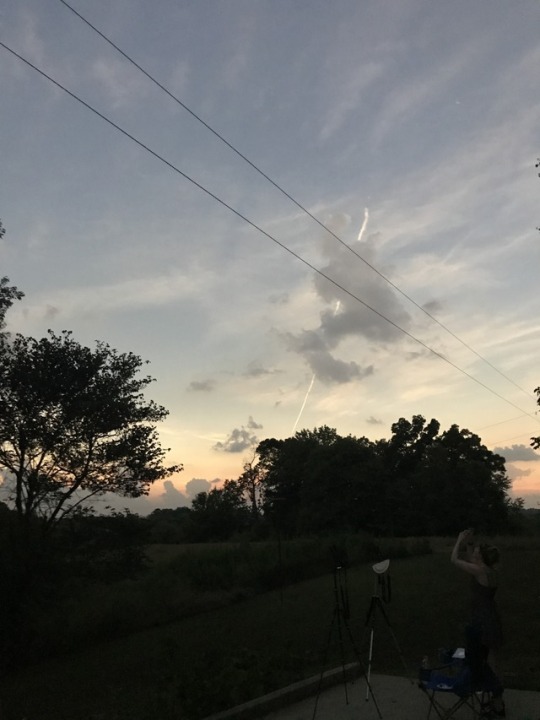#and also driving to southern illinois for the solar eclipse
Text
Holy Astronomy, Batman!
So, as some of you may or may not be aware, the continental United States is going to be treated to a solar eclipse on August 21st of this year. As I work for a large scientific institution in Illinois, where we are actually pretty close to the path of the eclipse, we had an educator from our nearest astronomic science institution (Hello, Adler Planetarium!) come out to talk to our staff about the eclipse, how much we'll see (84% totality!) and why we should consider NOT trying to drive to Carbondale that day (Hurricane evacuation route level traffic) for the full 100% coverage they'll be getting in Southern Illinois.
But you know what else she shared with us? There were two (2!!) solar eclipses during the Revolutionary War - one on June 24th of 1778 that passed over the Carolinas, and one on October 27th of 1780 with the path cutting through (what is now) Maine.
And all I could think of was a certain science nerd we all know begging, borrowing, and pleading with his supervisor to give him time off to go watch an eclipse.

(Want to know more about this year's eclipse and your chances for seeing it? Check out nasa.gov for more details. They’ve also got a map of the eclipse’s path, if you want to plan a day trip.)
45 notes
·
View notes
Photo



Sorry for the scarcity of recent posts. I went camping in the path of totality for the eclipse and it was a-freaking-mazing! I didn't try to take any pictures of the the sun during because I wanted to just be in the experience. I do have some of what the sky looked like during totality though. This was 1:23 on a freaking hot August afternoon in Southern Illinois. Totality was surreal but the approach was also amazing. It started to get dramatically darker and, I think surreal is honestly the best way to describe it. If you ever have the opportunity to see a total solar eclipse DO IT. I am so so so glad I did. It was well worth the drive, the heat, and the 30+ bug bites.
3 notes
·
View notes
Text
Follow along as the view of the eclipse makes its way across the US
Americans with telescopes, cameras and protective glasses staked out viewing spots along a narrow corridor from Oregon to South Carolina to watch the moon blot out the midday sun Monday in what promised to be the most observed and photographed eclipse in history.
Eclipse-watchers everywhere — and millions were expected to peer at the sun — fretted about the weather and hoped for clear skies for the first total solar eclipse to sweep coast-to-coast across the U.S. in practically a century.
The first to see the eclipse will be people along Oregon’s west coast. You can follow along and watch the shadow cross the country and make its way to KC on NASA’s live stream.
As he set up telescopes, Ray Cooper, a volunteer with the Oregon Museum of Science and Industry in Salem, worried offshore clouds might roll in and spoil the less than two-minute show.
“If it stays like this, it will be perfect,” Cooper said on the eve of the big day. He has seen full solar eclipses before, but never so close to home, making this one extra special.
With 200 million people within a day’s drive of Monday’s path of totality, towns and parks braced for monumental crowds.
In Salem, a field outside the state fairgrounds was transformed into a campground in advance of an eclipse-watching party for 8,500, courtesy of the Oregon Museum of Science and Industry.
“It’s one of those ‘check the box’ kind of things in life,” said Hilary O’Hollaren, who drove 30 miles from Portland with her two teenagers and a tent, plus a couple friends.
Astronomers consider a full solar eclipse the grandest of cosmic spectacles.
The Earth, moon and sun line up perfectly every one to three years, briefly turning day into night for a sliver of the planet. But these sights normally are in no man’s land, like the vast Pacific or Earth’s poles. This will be the first eclipse of the social media era to pass through such a heavily populated area.
In a case of near-perfect celestial symmetry, the sun is 400 times the breadth of our moon and also 400 times farther away, so the two heavenly bodies look more or less the same size from our vantage point, and the moon can neatly cover up the sun.
The moon hasn’t thrown this much shade at the U.S. since 1918. That was the country’s last coast-to-coast total eclipse.
In fact, the U.S. mainland hasn’t seen a total solar eclipse since 1979 — and even then, only five states in the Northwest experienced total darkness.
Monday’s total eclipse will cast a shadow that will race through 14 states, entering near Lincoln City, Oregon, at 1:16 p.m. EDT, moving diagonally across the heartland over Casper, Wyoming, Carbondale, Illinois, and Nashville, Tennessee, and then exiting near Charleston, South Carolina, at 2:47 p.m. EDT.
The path will cut 2,600 miles (4,200 kilometers) across the land and will be just 60 to 70 miles (96 kilometers to 113 kilometers) wide. Shawnee National Forest in southern Illinois will see the longest stretch of darkness: 2 minutes and 44 seconds.
Mostly clear skies beckoned along much of the route, according to the National Weather Service.
All of North America will get at least a partial eclipse. Central America and the top of South America will also see the moon cover part of the sun.
NASA and other scientists will be watching and analyzing from telescopes on the ground and in orbit, the International Space Station, airplanes and scores of high-altitude balloons, which will beam back live video. Citizen scientists will monitor animal and plant behavior as daylight turns into twilight and the temperature drops.
NASA’s associate administrator for science missions, Thomas Zurbuchen, took to the skies for a dry run Sunday. He planned to usher in the eclipse over the Pacific Coast from a NASA plane.
“Can’t wait for the cosmic moment MON morning,” he tweeted.
Near Victoria, British Columbia, where 91 percent of the sun will be eclipsed, science and math teacher Clayton Uyeda was going to watch from a ferry along with his wife. He said he was “expecting to have a real sense of connection with the heavens.”
He had similarly lofty hopes for his students if they could bring themselves to look up at the sky instead of down at their electronic devices.
Scientists everywhere agree with Uyeda: Put the phones and cameras down and enjoy the greatest natural show on Earth with your own (protected) eyes.
The only time it’s safe to look directly without protective eyewear is during totality, when the sun is 100 percent covered. Otherwise, to avoid eye damage, keep the solar specs on or use pinhole projectors that can cast an image of the eclipse into a box.
The next total solar eclipse in the U.S. will be in 2024. The next coast-to-coast one will not be until 2045.
from FOX 4 Kansas City WDAF-TV | News, Weather, Sports http://fox4kc.com/2017/08/21/follow-along-as-the-view-of-the-eclipse-makes-its-way-across-the-us/
from Kansas City Happenings https://kansascityhappenings.wordpress.com/2017/08/21/follow-along-as-the-view-of-the-eclipse-makes-its-way-across-the-us/
0 notes